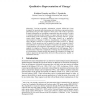Free Online Productivity Tools
i2Speak
i2Symbol
i2OCR
iTex2Img
iWeb2Print
iWeb2Shot
i2Type
iPdf2Split
iPdf2Merge
i2Bopomofo
i2Arabic
i2Style
i2Image
i2PDF
iLatex2Rtf
Sci2ools
COSIT
1997
Springer
1997
Springer
Qualitative Representation of Change
Current geographic information systems (GISs) have been designed for querying and maintaining static databases representing static phenomena and give little support to those users who wish to represent dynamic information or incorporate temporality into their studies. In order to integrate phenomena that change over space and time in GISs, a better understanding of the underlying components of change and how people reason about change is needed. This paper focuses on a qualitative representation of change. It offers a classification of change based on object identity and the set of operations that either preserve or change identity. These operations can be applied to single or composite objects and combined to express the semantics of sequences of change. An iconic, visual language is developed to represent the various types of change and applied to examples to illustrate the application of this language. Such a formalization of the basic components of change lays the foundation for a ...
| Added | 07 Aug 2010 |
| Updated | 07 Aug 2010 |
| Type | Conference |
| Year | 1997 |
| Where | COSIT |
| Authors | Kathleen Hornsby, Max J. Egenhofer |
Comments (0)

